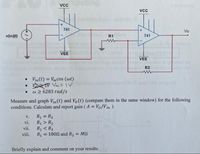
Introductory Circuit Analysis (13th Edition)
13th Edition
ISBN: 9780133923605
Author: Robert L. Boylestad
Publisher: PEARSON
expand_more
expand_more
format_list_bulleted
Concept explainers
Question

Transcribed Image Text:vcc ng
Vcc
741
Vo
v(in)(t)
R1
741
VEE
VEE
R2
• Vin (t) = Vm cos (@t)
1V Vm= V
w 2 6283 rad/s
%3D
Measure and graph Vin (t) and V(t) (compare them in the same window) for the following
conditions. Calculate and report gain ( A = Vo/V in ).
R1 = R2
R > R2
R1 < R2
R, = 1002 and R2 = MN
V.
%3D
vi.
vii.
viii.
%3!
Briefly explain and comment on your results.
Expert Solution
This question has been solved!
Explore an expertly crafted, step-by-step solution for a thorough understanding of key concepts.
This is a popular solution
Trending nowThis is a popular solution!
Step by stepSolved in 6 steps with 6 images

Knowledge Booster
Learn more about
Need a deep-dive on the concept behind this application? Look no further. Learn more about this topic, electrical-engineering and related others by exploring similar questions and additional content below.Similar questions
- Use source transformation to find the output current loin the circuit given below, where V₁ = 40 30° V, XL = 50 2₂ Xc= 2002, R₁ = R₂ = 80 02, and V2 = 100 V. Please report your answer so the magnitude is positive and all angles are in the range of negative 180 degrees to positive 180 degrees. jXL V₁ R₁ www R₂ www -jXc The output current in the given circuit is V₂ °A.arrow_forwardB + Vin + Avin + Re Evr The Cir Cuit Shown has the following values R₁ =2000 2₂₁ = 4k₁₂², K3= 150v2 and Ry = 1 kur. The gain of the dependent Source A = 30 and Vsig = somu. Determine the vale of Vin In mu Vahe oF UL in V Determine thearrow_forward1. Recall the following setup from HW4: you are setting up a pair of PA speakers on a field in preparation for an outdoor event. Each speaker is 0.65 m wide, and the speakers have a center-to-center separation of 8.2 m. To test the speakers your coworker plays a single tone through the speakers whose frequency is 440 Hz. You are standing 52 m directly in front of the speakers and facing them. (a) Would you expect there to be any diffraction minima in this setup? If so, where? If not, why not? (b) Suppose we wish to create a directed beam of sound waves with that same frequency, 440 Hz. If we want the total width of this directed beam to increase by at most 5 m for every 100 m the beam goes forward, what is the smallest speaker we could use for this purpose?arrow_forward
Recommended textbooks for you
 Introductory Circuit Analysis (13th Edition)Electrical EngineeringISBN:9780133923605Author:Robert L. BoylestadPublisher:PEARSON
Introductory Circuit Analysis (13th Edition)Electrical EngineeringISBN:9780133923605Author:Robert L. BoylestadPublisher:PEARSON Delmar's Standard Textbook Of ElectricityElectrical EngineeringISBN:9781337900348Author:Stephen L. HermanPublisher:Cengage Learning
Delmar's Standard Textbook Of ElectricityElectrical EngineeringISBN:9781337900348Author:Stephen L. HermanPublisher:Cengage Learning Programmable Logic ControllersElectrical EngineeringISBN:9780073373843Author:Frank D. PetruzellaPublisher:McGraw-Hill Education
Programmable Logic ControllersElectrical EngineeringISBN:9780073373843Author:Frank D. PetruzellaPublisher:McGraw-Hill Education Fundamentals of Electric CircuitsElectrical EngineeringISBN:9780078028229Author:Charles K Alexander, Matthew SadikuPublisher:McGraw-Hill Education
Fundamentals of Electric CircuitsElectrical EngineeringISBN:9780078028229Author:Charles K Alexander, Matthew SadikuPublisher:McGraw-Hill Education Electric Circuits. (11th Edition)Electrical EngineeringISBN:9780134746968Author:James W. Nilsson, Susan RiedelPublisher:PEARSON
Electric Circuits. (11th Edition)Electrical EngineeringISBN:9780134746968Author:James W. Nilsson, Susan RiedelPublisher:PEARSON Engineering ElectromagneticsElectrical EngineeringISBN:9780078028151Author:Hayt, William H. (william Hart), Jr, BUCK, John A.Publisher:Mcgraw-hill Education,
Engineering ElectromagneticsElectrical EngineeringISBN:9780078028151Author:Hayt, William H. (william Hart), Jr, BUCK, John A.Publisher:Mcgraw-hill Education,

Introductory Circuit Analysis (13th Edition)
Electrical Engineering
ISBN:9780133923605
Author:Robert L. Boylestad
Publisher:PEARSON

Delmar's Standard Textbook Of Electricity
Electrical Engineering
ISBN:9781337900348
Author:Stephen L. Herman
Publisher:Cengage Learning

Programmable Logic Controllers
Electrical Engineering
ISBN:9780073373843
Author:Frank D. Petruzella
Publisher:McGraw-Hill Education

Fundamentals of Electric Circuits
Electrical Engineering
ISBN:9780078028229
Author:Charles K Alexander, Matthew Sadiku
Publisher:McGraw-Hill Education

Electric Circuits. (11th Edition)
Electrical Engineering
ISBN:9780134746968
Author:James W. Nilsson, Susan Riedel
Publisher:PEARSON

Engineering Electromagnetics
Electrical Engineering
ISBN:9780078028151
Author:Hayt, William H. (william Hart), Jr, BUCK, John A.
Publisher:Mcgraw-hill Education,